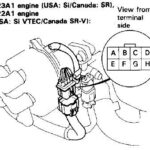Experiencing a dead OBD2 port on your 2004 Ford F150 can be a frustrating roadblock, especially when you need to diagnose engine issues or pass emissions tests. The OBD2 port, or Data Link Connector (DLC), is essential for communicating with your truck’s computer systems. If you’re facing a “no power at OBD2 port” situation on your 2004 Ford F150, this guide will walk you through systematic troubleshooting steps to help you pinpoint the problem and restore communication.
Common Causes and How to Troubleshoot a Dead OBD2 Port
Let’s delve into the potential culprits behind a lack of power at your OBD2 port and how you can investigate each one.
1. Check Fuse #22: The First Suspect
Fuse #22 in the under-dash fuse panel is a prime suspect when dealing with a dead OBD2 port on a 2004 Ford F150. It’s crucial to start your diagnosis here.
- Action: Locate fuse #22 and inspect it. Even if the fuse looks intact, replace it with a new fuse of the same rating to eliminate any subtle issues.
- Voltage Test: Use a multimeter to check for voltage on both sides of the fuse. You should ideally see battery voltage (~12V). If you’re only seeing around 2V, as mentioned in the original scenario, this is abnormal and indicates a problem upstream or a voltage drop. However, ensure your multimeter is properly grounded for accurate readings.
2. Instrument Cluster (INST) Issues
While less common, a malfunctioning Instrument Cluster can sometimes interfere with the CAN Bus communication, leading to OBD2 port problems.
- Action: Try disconnecting the Instrument Cluster. It usually has two plugs at the back. Disconnect these plugs and then re-check for power at your OBD2 port.
- Note: Disconnecting the instrument cluster might affect other vehicle functions temporarily, but it’s a useful diagnostic step.
3. Aftermarket Trailer Brake Controller (TBC) Interference
An improperly installed or faulty aftermarket Trailer Brake Controller can sometimes disrupt the vehicle’s electrical system and CAN Bus, causing issues with the OBD2 port.
- Action: If you have an aftermarket TBC installed, disconnect it completely. This includes unplugging it from its harness. After disconnecting, re-test your OBD2 port for power.
4. PCM Connector Problems
The Powertrain Control Module (PCM) is the brain of your Ford F150, and it supplies power to the OBD2 port. Issues with the PCM connectors can interrupt this power supply.
- Action: Locate the PCM connectors. On a 2004 Ford F150, there are typically connectors near the radiator and a center connector. Disconnect the center PCM connector and the PCM connector closest to the radiator. Then, check if OBD2 port communication is restored.
5. Sensor Disconnections: MAP, MAF, WIF, and Fuel Pump
Certain sensors can, in rare cases, cause communication problems if they are shorted or malfunctioning. Disconnecting a few key sensors can help rule out sensor-related issues.
- Action: Disconnect the following sensors one at a time, testing the OBD2 port after each disconnection:
- MAP Sensor (Manifold Absolute Pressure)
- MAF Sensor (Mass Air Flow)
- WIF Sensor (Water-in-Fuel, if applicable)
- Fuel Pump (electrical connector)
6. Verify Voltage at DLC Pin #16
Pin #16 of the OBD2 port is designated for battery voltage. Checking this pin directly confirms if the port is receiving power.
- Action: Use a multimeter to check for voltage at Pin #16 of the OBD2 port. You should consistently see battery voltage, around 12.9V when the engine is off. If there’s no voltage here, or significantly lower voltage, it indicates a power supply issue to the port itself.
Understanding Voltage Readings
- Pin #16 (DLC): Should have 12V at all times (battery voltage). This is the main power supply to the OBD2 port.
- Red Wire (likely at EGR valve connector, as mentioned in the original post): Should have 12V. This is another point where 12V power should be present, supplied by the PCM.
- BN/WH Wire (likely at EGR valve connector): Should have 5V. This is a 5V reference voltage, also supplied by the PCM, used by some sensors.
Throttle Position Sensor (TPS) and P0121 Code
The original poster mentioned a recurring P0121 code (Throttle Position Sensor circuit range/performance problem) before the OBD2 communication issue arose. While less likely to directly cause a “no power” situation at the OBD2 port, a severe TPS circuit fault could potentially impact the PCM’s overall function and indirectly affect communication.
- Consideration: While troubleshooting the “no power” issue, keep the TPS and P0121 code in mind. If the primary power and communication checks don’t resolve the problem, further investigation into the TPS circuit might be necessary.
Conclusion: Step-by-Step Troubleshooting for a Dead OBD2 Port
Troubleshooting a “2004 Ford F150 No Power At Obd2 Port” requires a methodical approach. By systematically checking fuses, disconnecting potential interfering components like the instrument cluster and aftermarket TBC, verifying PCM connections, and testing key sensors, you can effectively narrow down the source of the problem. Remember to utilize a multimeter to confirm voltage at crucial points like Fuse #22 and DLC Pin #16. If these steps don’t restore power to your OBD2 port, it’s recommended to consult a qualified automotive technician for further diagnosis and repair.
